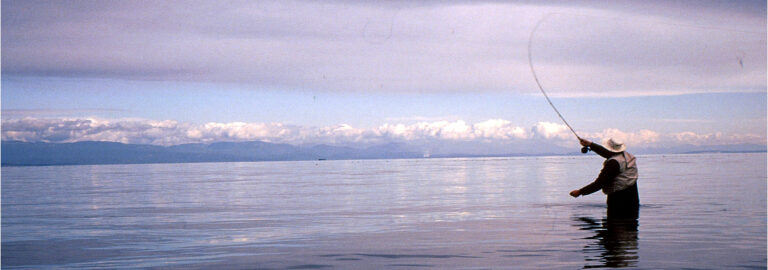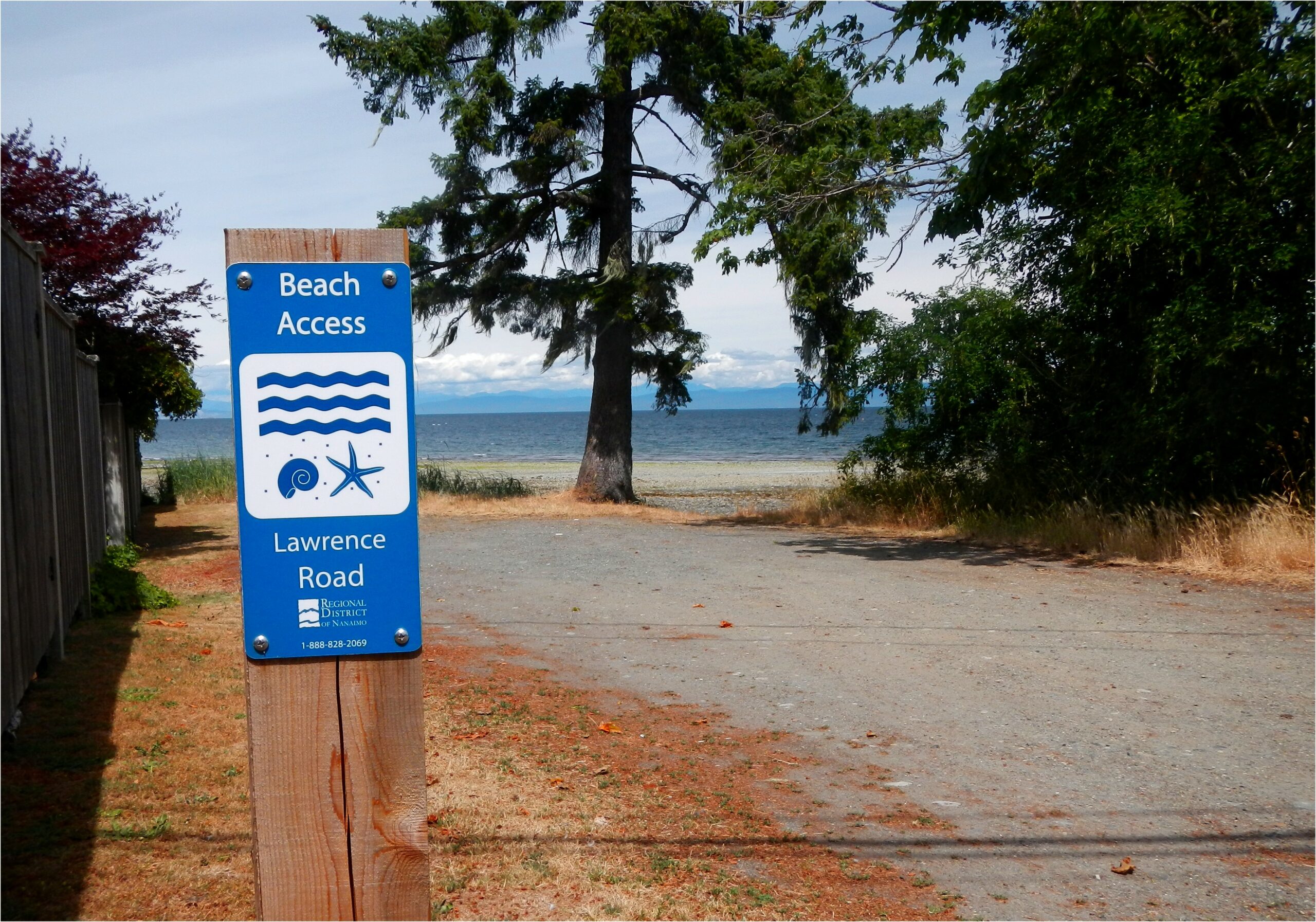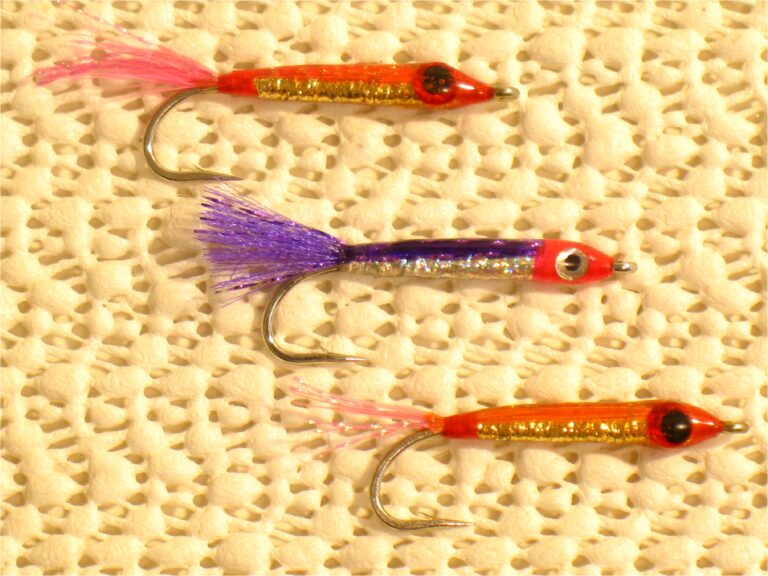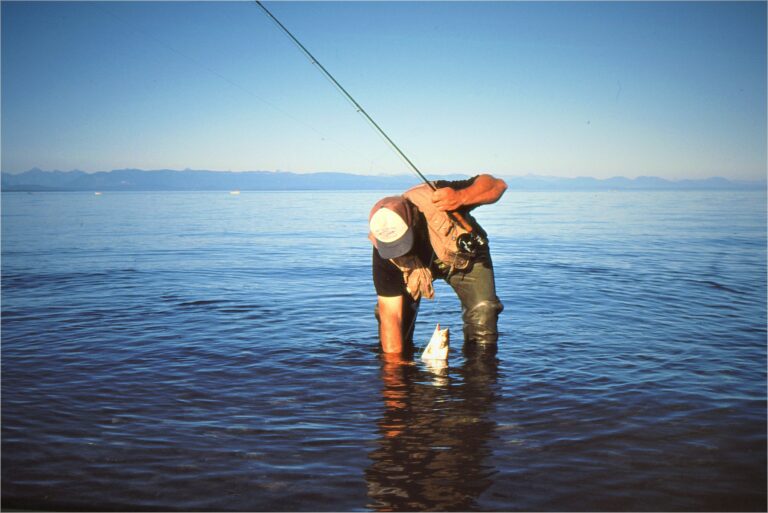
Fly fishers calling East-central Vancouver Island home are fortunate to have some great fly-fishing opportunities close at hand. Fly-fishing for Pacific salmon off the beach, especially for Coho and Pink salmon, has skyrocketed in popularity. That stretch of salt water coastline, say from Kuhushan Point in the north, to Parksville Bay in the south, about 86 kilometers as the crow flies, offers ready access to a number of beach fishing locales. Each in their own season, Pink salmon and Coho salmon are the main attraction.
Feeding into this region, larger rivers like the Oyster, Puntledge, Trent, Tsable, Big Qualicum, Little Qualicum and Englishman support good runs of salmon. As well, numerous small streams like Black Creek, Kitty Coleman Creek, Little River, Millard Creek, Roy Creek, Cook Creek and Nile Creek to name only a handful, sustain discrete runs of salmon. There is a mix of wild-bred and hatchery augmented fish emanating from several of those waters mentioned. They all add to the biomass; some add pinks, some Coho, some yield both. In total, that makes for a lot of great saltwater fly-fishing potential.

Accessing the fishery
Fortunately, Highway 19A roughly parallels Vancouver Island’s eastern coastline and is often appropriately called the Oceanside route. Sometimes it comes so close to the waters edge that in places, winter storms toss debris onto it with a surging high tide. Any up-to-date road map of the Island, a digital cartography app on an electronic device, or clicking on Google earth™ via computer will show the highway/coastline interface in detail. Many beach access points are easily recognizable, while others may require some sleuthing and ground-truthing. Suffice to say, public beach access here is well established as a right; very little private property extends down past the high tide line. For ease of recognition, many established beach access points have been conveniently posted with official signage by the Regional District. Some beach access points even incorporate a wooden bench situated for ease of viewing the tidal tableau; most are standard, sturdy but plain, government issue models, while a few others are custom carved works of art.
For the most part, good fishing beaches in this region are of shallow gradient, with a mix of sand, gravel and rock for a bottom. This combination makes for relatively easy wading. Tidal flows over most beaches are gentle; so, no fear of getting swept away by a fast flowing tidal surge. Waves, on the other hand, can mount along any beach, due to the combination of prevailing wind/tide/seasonal weather conditions. Employing good common sense is the overriding factor in ensuring personal safety while fly-fishing off the beach.
Gearing up
Anyone with some basic fly-fishing knowledge will grasp the concept of casting to fish in saltwater. Newcomers to the challenge will get a leg up by watching other fly fishers and asking questions of them. Most veteran beach rats are happy to share solid advice when it comes to tackle and flies; maybe not so much when asked where to fish, as they can be guarded about favourite fishing spots. Should you wish to get started in the sport, a basic fly rod, reel and line is all that’s required, and needn’t be too costly. A nine-foot, 6wt. rod will get you started. Any decent quality fly reel, with sufficient line capacity and plenty of backing will do. The fly line can be either a full floating, intermediate sinking type, or a combination floating running line with an intermediate sink-tip. These three types offer specific benefits and each has their own league of disciples. A fly shop employee can give a run down on the attributes of each type.
Leader/tippet combinations are simple, as these fish are not leader shy. Fluorocarbon leader material is great, as it offers best strength to diameter ratio and is all but invisible in the water. For the most part, simply a rods’ length of straight fluoro will suffice. Using eight to ten pound breaking strain fluorocarbon leaders offers the best chance of attracting and holding a salmon. It goes without saying, a well-tied knot is your best friend. Most beach flies are on the small, sparse side as the water is fairly clear, so, too thick a leader will result in fewer fish striking the fly; play your fish with sensitivity and all will be well. If your tackle is not corrosion resistant, a good washing down with clear water at the end of the trip will allay the effects of saltwater damage.
A low-cost tidal water angling licence is required and can be obtained conveniently online from the Fisheries & Oceans Canada website. Through that website, angling regulations, localized closures and species specific quotas are found; look under Region One, Area 14.
A pair of good quality, compact binoculars comes in handy for scoping out distant stretches of beach while searching for tell-tale signs of fish, or fish catching activity. Wearing a pair of well-fitted chest waders will provide comfort while wading deep into the briny. Topping the waders with a waterproof hooded jacket, to shed rain and to stop big waves from spilling into the waders when wading deeply, will keep you dry and comfy. Sundries like sunglasses, wide-brimmed hat, fly fishing vest or tackle pack can be useful. Oh yes, add a few well chosen fly patterns to round out your beach angler’s necessities.
Some useful patterns
In general, fly pattern choice is determined by which species of salmon you are pursuing; with some occasional overlap. The traditional mantra “pink is for pinks” stands the test of time and is a good starting point. Some notable veteran beach fishers even tie-up convincing imitations of pink shrimp for Pink salmon. For whatever reason, flies with some blue-green characteristics make good change-up flies when pink ones fail to produce. A polar bear hair winged Pink ‘n’ Silver; a pink Candy fly; or a small Kelsey’s Hope bucktail are good tried and true patterns to start off with.
For Coho, there may be some overlap with those previous flies, but, specific patterns have evolved for catching Coho. The aforementioned Candy fly in purple, the Olive Wizard fly – both originated by long time beach fisher Art Limber, are two notables. The polar bear hair winged Pearl Mickey and the Green & Silver are consistent Coho catchers. There are many other effective personal favourites amongst beach fishing regulars, like Neil’s euphausiid – aka “California Neil”. The customary hook size for these flies are size sixes and eights – super sharp and debarbed. Be sure to have a few of each of those patterns listed as they cover most circumstances.

Pink and coho salmon
After finding a good beach where the fish may currently be located, through asking at a fly fishing shop or looking for other fly fishers already gathered there, take a moment to actually spot the fish and plot their movements. Pinks will travel slowly in small groups near the surface, pushing a slight telltale bow wake. Other times all that shows are tips of tails poking through the surface like so many miniature sailboats all heading in the same direction. Being courteous to others already there, wade into a position where you can cast your fly to a place slightly ahead of the roving school. Let it sink a moment or two while the fish move closer to it. A straight line connection with your fly is paramount in detecting the gentle strike of a Pink salmon.
A most consistent fly for catching Coho is the polar bear hair winged, topped with pearlescent Flashabou™, Pearl Mickey. As with Pink salmon flies, many other personal favourites exist amongst fellow beach-rats. Coho seem to be a bit more willing to chase after a fly than are pinks. Methods of finding and casting to both kinds of salmon are the same. The fly manipulation technique varies more with Coho than with pinks. A slow, steady hand-twist is good for a start. Accentuate that with an occasional quick, short strip-in of line to catch the fish’s attention. Often, a continual fast strip-in of line, rod tucked under arm hand over hand rolly-poly style, to stimulate a chase response, will trigger a solid take. At other times, when Coho are milling about in tight groups and the fly is cast near to the pod, simply the plip sound of the fly hitting the surface will trigger a reflexive strike.

Even a modest sized Pink salmon, or a small three-pound Coho “jack” can really put a bend in the rod and run-out a goodly length of fly line, sometimes well into the backing. Best advice; either the salmon should be pulling line out or you should be pulling it in, and getting it safely back on the reel as quickly as you can. Pretty much the same technique applies for full-size adult salmon, only the duration of the tussle will be significantly longer; much longer and more intense when hooked into a late season “Northern” Coho weighing in the teens of pounds. Remember, these salmon, whether they be pinks or Coho, are at their pinnacle of strength and endurance capability, so be prepared for a good contest.
To finish, some folks use a landing net, others prefer to tail a salmon, yet others will steer a fish into the shallows next to the shore. Whichever technique is used often depends on the fly fisher’s ability; or whether a fish is being harvested; or if regulations do not allow its retention and it must be safely released; or is simply determined by the temperament of the individual fish – some salmon seem to never want to give up.
